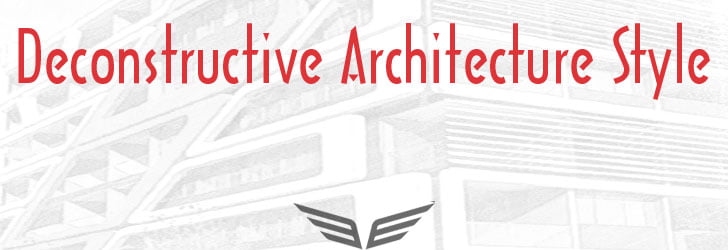Deconstruction architecture concept: Deconstructivism in architecture style is characterized by ideas of fragmentation. An interest is in manipulating ideas of a structure’s surface or skin, non-rectilinear shapes. Which serve to distort and dislocate some of the elements of architecture, such as structure and envelope. The finished deconstructivism examples visual appearance of buildings that exhibit the many deconstructivism architecture style is characterized by a stimulating unpredictability and a controlled chaos. Deconstructive architecture style was a development of postmodern contemporary architecture that began in the late 1980s.
Deconstructivism Architecture Style

Key Features of Deconstructivism Architecture Style:
- Unrelated forms.
- Abstract in nature.
- Smooth exterior surfaces.
- Contrast of shapes and forms.
- Large expanses of a single material (glass, metals, stones, etc.).
- Window frames often hidden in the walls.
- Simple metal frame doors.
- Exposed materials.
A Quick Overview about Background of deconstruction architecture concept:
Originally, some of the architects known as Deconstructivists were influenced by the ideas of the French philosopher Jacques Derrida. Eisenman developed a personal relationship with Derrida, but even so his approach to architectural design was developed long before he became a Deconstructivist. For him Deconstructive Architecture Style should be considered an extension of his interest in radical formalism. Some practitioners of deconstructivism in architecture style were also influenced by the formal experimentation and geometric imbalances of Russian constructivism. There are additional references in deconstructivism to 20th-century movements: the modernism- postmodernism interplay, expressionism, cubism, minimalism and contemporary art. (Ref: http://en.wikipedia.org/wiki/Deconstructivism)
Important Events in the History of deconstructivism architecture:
Important events in the history of the deconstructivism movement include the 1982 Parc de la Villette architectural design competition (especially the entry from Jacques Derrida and Peter Eisenman and Bernard Tschumi’s winning entry), the Museum of Modern Art‘s 1988.
Deconstructivism in architecture style exhibition in New York, organized by Philip Johnson and Mark Wigley, and the 1989 opening of the Wexner Center for the Arts in Columbus, designed by Peter Eisenman.
Since the exhibition, many of the architects who were associated with Deconstructivism have distanced themselves from the term. Nonetheless, the term has stuck and has now, in fact, come to embrace a general trend within contemporary architecture.
Computer aided design is now an essential tool in most aspects of contemporary architecture, but the particular nature of deconstrucivism makes the use of computers especially pertinent.
Three-dimensional modeling and animation (virtual and physical) assists in the conception of very complicated spaces, while the ability to link computer models to manufacturing jigs (CAM – Computer-aided manufacturing) allows the mass production of subtly different modular elements to be achieved at affordable costs.
In retrospect many early deconstructivist works appear to have been conceived with the aid of a computer, but were not; Zaha Hadid’s sketches for instance.
Frank Gehry is noted for producing many physical models as well as computer models as part of his design process. Though the computer has made the designing of complex shapes much easier, not everything that looks odd is “deconstructivist.”
Deconstructivism characteristics is beautiful:
Deconstructive Architecture Style in contemporary architecture stands in opposition to the ordered rationality of Modernism. Its relationship with Postmodernism is also decidedly contrary.
Deconstructivism took a confrontational stance toward much of architecture and architectural history, wanting to disjoin and disassemble architecture.
While postmodernism returned to embrace – often slyly or ironically – the historical references that modernism had shunned, deconstructivism rejects the postmodern acceptance of such references.
It also rejects the idea of ornament as an after-thought or decoration. (Source: http://en.wikipedia.org/wiki/Deconstructivism)
You may also like to read,
- Japanese Style Dining Tables can give Your Interior Design Identity.
- House Design Styles tell Who and What are you Actually !!!
- Mexico City’s New Baseball Stadium Architecture and Design.
- 7 points how to Start Design in Architecture.
- Museum of Biodiversity Designed by Frank Gehry.
- Zaha Hadid Architects completed the Issam Fares Institute of Beirut.
Quick Questions
- Is deconstruction in architecture is really beautiful?
- Why general category not able to digest or acceptance of deconstructism?
- Is decorative elements of design not include in deconstruction architecture style?
- Is balance of expression achievable in deconstruction?
- Deconstructive architecture style accepted locally?








Leave a Comment
You must be logged in to post a comment.